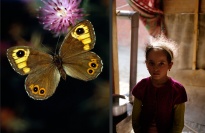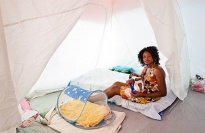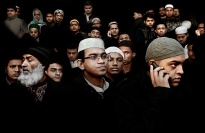About Moving Walls 19
In 1997, when the New York headquarters of the Open Society Foundations moved to our previous location at 400 West 59th Street, a photography exhibition was not part of the plan. Yet, the space’s many large, empty walls presented an opportunity to feature imagery that would amplify our mission. The Foundations’ president, Aryeh Neier, asked Magnum Photos photographer Susan Meiselas—with whom he had worked for many years when he was the executive director of Human Rights Watch—for ideas. And with that, the Moving Walls exhibition was born.
The idea was to feature, on a rotating basis, documentary photography that was connected to issues addressed by the Foundations. The name Moving Walls was chosen to reflect obstacles to equality and justice, and to highlight the struggles to “move walls,” that is, to tear those barriers down.
Now, 14 years later, the Open Society Foundations have exhibited the work of over 150 photographers and examined timely and significant human rights and social justice issues. Looking back at the past 19 exhibits that we’ve organized in that period, one can get a sense of the Foundations’ activities over the years. Reflecting the origins of our work are photographs that documented countries experiencing transition after the break-up of the Soviet Union. Moving Walls photographers have also explored the impact and aftermath—on both a societal and individual level—of political turmoil, conflict, and war in regions such as Asia, the Balkans, Central and Western Africa, Latin America, and the Middle East. Public health issues, a major focus for the Foundations, were examined through projects that highlight the AIDS epidemic, palliative care, and the mistreatment and institutionalization of people with mental disabilities. Another cross-cutting theme, the rights of marginalized people, has been revealed in photographs that document both the discrimination faced by Roma, LGBTQ, stateless, indigenous, and various faith groups, and the resilience of these people as they confront challenges and go about their lives. Photographs from Burma and North Korea have depicted how systems of authoritarian power play out in closed societies, whereas images of the U.S. criminal justice system have reminded us that even in so-called “open” societies, there are large numbers of people who suffer from unjust treatment and discriminatory policies. Natural resource exploitation, global migration, the transformation of traditional societies into modern, heavily industrialized nations, and the rise of China are also themes that have been examined in a range of contexts.
With Moving Walls 19, we continue our ongoing commitment to highlighting photography that explores the intersection between the obstruction of justice and those who work to break those walls down. In James Mackay’s portraits, political dissidents from Burma pose with the names of political prisoners written on their raised palms, to pay tribute to and stand in solidarity with their peers, some of whom remain imprisoned for their activities and beliefs. Pete Muller shows justice at work in the context of an innovative mobile court system that holds civilians and military personnel accountable for rapes that were perpetuated as a tool for war in the Democratic Republic of Congo.
Photographs by Greg Constantine and John Willis reflect the experiences of people who have historically been denied their rightful claim to their land, and have suffered discrimination and barriers to employment and quality education as a result. Constantine’s images of stateless Nubians in Kenya are shown alongside historical images from Nubians’ personal collections, while Willis’s photographs are exhibited with not only archival images from Pine Ridge, but also drawings by Oglala Lakota artist Dwayne Wilcox. By combining their own images with those from the communities they’re documenting, Constantine and Willis set up a compelling and dynamic interplay between the perspectives of those who live inside and outside these communities.
Rena Effendi takes a similar, but more personalized, approach by pairing her own photographs—of people living in areas polluted by the oil industry in Baku, Azerbaijan—with photographs of butterflies taken by her late father, an environmental activist and entomologist who dedicated his life to collecting and studying over 90,000 butterfly species from the Caucasus and Central Asia. By juxtaposing these images taken across time, Effendi makes a statement about the fragility of nature and the environment.
Wyatt Gallery, too, references the vulnerability of the lived environment with photographs taken in the aftermath of the 2010 earthquake in Haiti. In contrast to images of despair and devastation that were in mainstream circulation, Gallery’s photographs focus on the ways in which Haitians took it upon themselves to reestablish a sense of normalcy within the tent cities where they live.
Bharat Choudhary’s portraits also show people grappling with their relationship to home as the political and cultural environment drastically changes around them. In Choudhary’s work, young Muslims in the United States and United Kingdom struggle with their sense of identity and belonging in the context of growing religious intolerance.
The 19th exhibition of Moving Walls will be the last in the current location. In early 2013, the headquarters of the Open Society Foundations moved again, this time to a building on 57th Street and Broadway. With this move, Moving Walls will continue to illuminate issues of importance to the Foundations and honor a mode of practice that values in-depth and nuanced visual explorations of pressing issues. As we anticipate this transition in the Foundations’ and our program’s history, we look forward to our new space, and pay tribute to the photographers and the greater photography, human rights, and social justice communities that have supported and enriched our work over the past 14 years.






